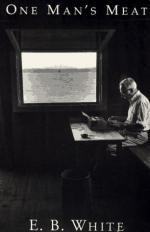|
This section contains 526 words (approx. 2 pages at 400 words per page) |

|
One Man's Meat Summary & Study Guide Description
One Man's Meat Summary & Study Guide includes comprehensive information and analysis to help you understand the book. This study guide contains the following sections:
This detailed literature summary also contains Topics for Discussion and a Free Quiz on One Man's Meat by E. B. White.
This book is a series of monthly columns written by E.B. White for Harper's magazine and The New Yorker magazine. The columns are intended to provide readers with information about White's experiences living on a saltwater farm in Maine.
White had worked for several years for The New Yorker magazine and makes the decision to move his wife and son from Manhattan to North Brooklin, Maine, in 1938, to experience a rural lifestyle on a working farm. White continues to write through the columns, and his wife, Katherine, also works in publishing, working at their farmhouse and using the U.S. mail for correspondence instead of going into an office.
In the opening columns of the book, White's transition from city life to a rural life is evident as he tries to decide which pieces of the household to sell and how to divest himself of the trappings of city life. Getting established in the Maine farmhouse is relatively easy as White determines the best way to write for a sophisticated magazine while also needing to tend to chickens and other farm work. White does not struggle long with the transition, however, and his delight in simple, rural pleasures and the satisfaction of manual labor soon become evident in his more relaxed style.
The book has a variety of content ranging from the activities demanded of a farmer in his everyday work to the musings about world powers during the period preceding the outbreak of World War II. Throughout the book White also draws parallels and differences between his peaceful farm life with the growing discontent in Europe in the years leading up to and including the first months of World War II. Prior to the war, White's columns are tinged with thoughts of dictators and occupied countries but as the war progresses, White admits to feeling ashamed that his thoughts are no longer consumed with the plight of the people in the war-torn countries.
White's writing shows him to be a sentimental man with a love for nostalgia and things of the earth. In fact, White is glad when his manual labor takes him away from his obligations of writing even if for a little while. White tries to pass on his love of the land and for the country to his son and there are mentions of conversations and purchased baseball gloves all dedicated to bonding with his only child. White makes brief mentions of his wife, Katherine, but neither she nor their son is a main topic in the columns.
White is very educated with a sophisticated wit but also very down to earth and humble. While his metropolitan friends warn him not to get too provincial in the country he silently wonders if he can save them from becoming too citified. White, however, moves about in both city and country life with ease and rubs elbows with intellectuals in New York City as well as men who fish for lobster to make a living. White's natural inquisitiveness makes him a great writer and excellent storyteller about a relatively uncomplicated life in a very complicated period in world history.
Read more from the Study Guide
|
This section contains 526 words (approx. 2 pages at 400 words per page) |

|



